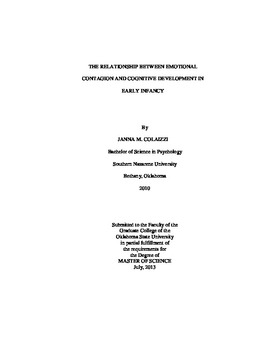| dc.description.abstract | Empathy incorporates cognitive and emotional responses (Hastings, Zahn-Waxler, & McShane, 2006), both of which have been widely studied at many developmental stages, revealing that attention (Braaten & Rosén, 2000), inhibition (Hansen, 2011), effortful control (Valiente, et al., 2004), and perspective-taking skills (Farrant, Devine, Maybery, & Fletcher, 2012) all influence emotional responding, i.e. empathy. In relation to empathy in infancy, however, these cognitive operations have not been thoroughly examined. Cognitive measures of attention, habituation, and memory were used as predictors of emotional contagion (as measured by latency to distress, duration, and intensity of distress, heart rate baseline and change, and baseline cortisol), a precursor of empathy, in infants at 3, 6, and 9 months of age (n = 37).Emotional measures of distress were assessed in response to recorded cries of another infant. Cognition was assessed through an infant-controlled habituation procedure using a static, adult face, and by two novelty preference trials. Heart rate and looking time toward the stimulus were recorded to examine attention, information processing speed, and memory. Salivary cortisol was assessed at the beginning of the procedure.More time spent in the disengaged attentional phase related to longer latency to distress, lower baseline heart rate, and lower baseline cortisol levels. A long latency to distress also related to less time in the sustained attention phase, failure to demonstrate an novelty preference, longer look duration, and fewer trials to habituation. Intensity was also negatively related to look duration. These findings suggest that a relationship between cognition and emotion may be observable in early infancy. More specifically, these findings indicate a potential relationship between faster processing speed (shorter look durations), attentional control (less time in the disengagement phase), and an increase in emotional sensitivity (shorter latency to distress) and emotion regulation (lower intensity).Some emotional and cognitive variables demonstrated consistency over time and demonstrate developmental patterns that are consistent with the current literature. Gender differences and maternal influences were also found. Maternal influences are discussed as an important contributor to infant emotional responding and socioemotional development. | |
